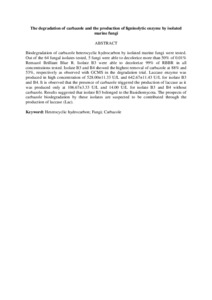Citation
Azri, Mohammad Farhan Darin and Zulkharnain, Azham and Awang Husaini, Awang Ahmad Sallehin and Ahmad, Siti Aqlima
(2015)
The degradation of carbazole and the production of ligninolytic enzyme by isolated marine fungi.
Journal of Chemical and Pharmaceutical Sciences, 8 (2).
pp. 330-335.
ISSN 0974-2115
Abstract
Biodegradation of carbazole heterocyclic hydrocarbon by isolated marine fungi were tested. Out of the 64 fungal isolates tested, 5 fungi were able to decolorize more than 50% of 0.01% Remazol Brilliant Blue R. Isolate B3 were able to decolorize 99% of RBBR in all concentrations tested. Isolate B3 and B4 showed the highest removal of carbazole at 88% and 53%, respectively as observed with GCMS in the degradation trial. Laccase enzyme was produced in high concentration of 528.00±11.33 U/L and 642.67±11.43 U/L for isolate B3 and B4. It is observed that the presence of carbazole triggered the production of laccase as it was produced only at 106.67±3.33 U/L and 14.00 U/L for isolate B3 and B4 without carbazole. Results suggested that isolate B3 belonged to the Basidiomycota. The prospects of carbazole biodegradation by these isolates are suspected to be contributed through the production of laccase (Lac).
Download File
![[img]](http://psasir.upm.edu.my/46539/1.hassmallThumbnailVersion/The%20degradation%20of%20carbazole%20and%20the%20production%20of%20ligninolytic%20enzyme%20by%20isolated%20marine%20fungi.pdf)  Preview |
|
Text (Abstract)
The degradation of carbazole and the production of ligninolytic enzyme by isolated marine fungi.pdf
Download (5kB)
| Preview
|
|
Additional Metadata
Actions (login required)
 |
View Item |

